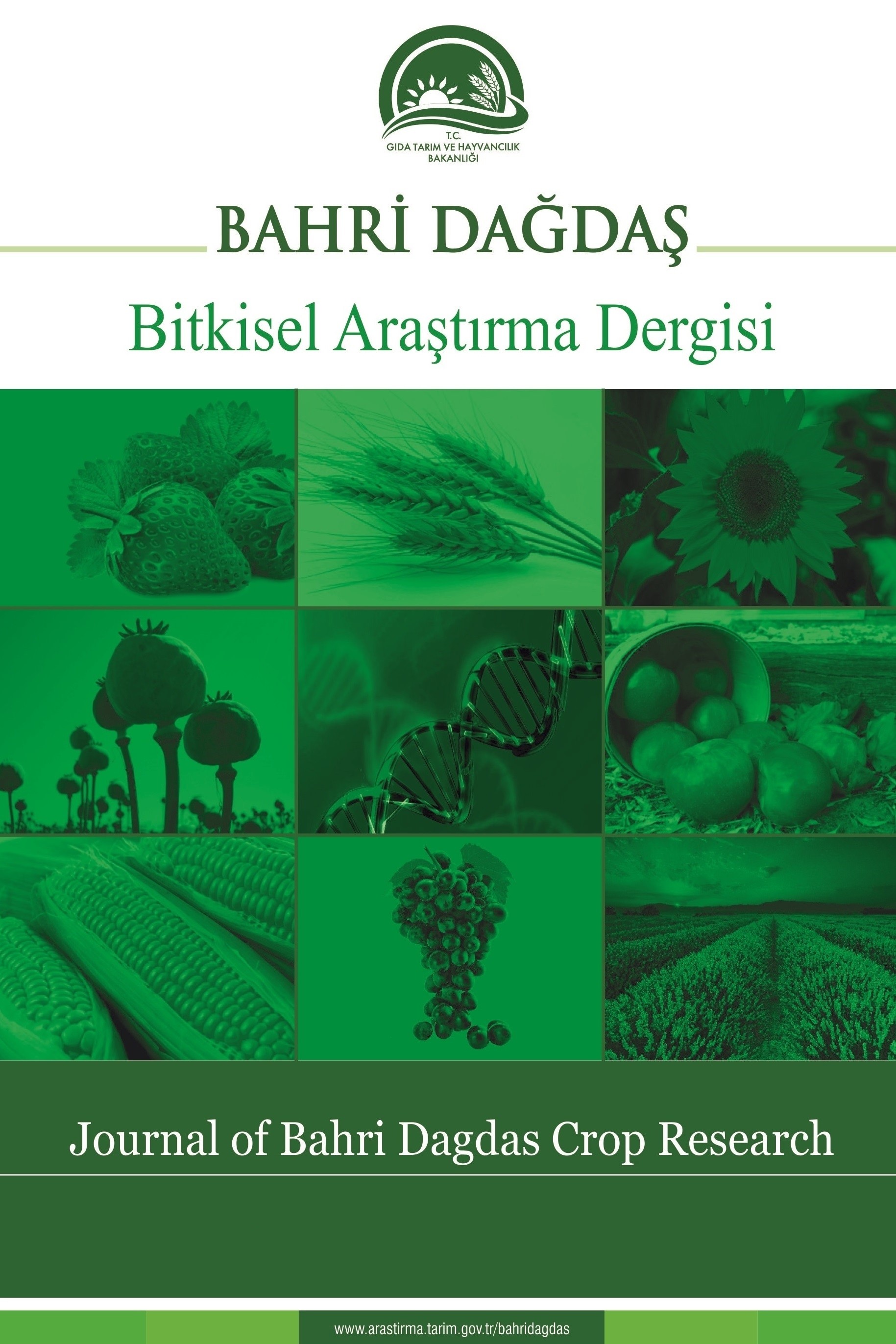Farklı Yüzey Aktif Maddelerin Domatesin Gelişimine Etkileri
Anyonik, katyonik, iyonik olmayan yüzey aktif maddeler, domates (Lycopersicon esculentum L.), sera
The Effects of Different Surfactants on the Growth of Tomato Plant
___
- Anonim, (1954). U.S. Salinity Laboratory Staff. Diagnosis and Improvement of Saline and Alkali Soils. Agri. Handbook No:60, USDA
- Bouyoucus, G. J. (1951). A recalibration of the hydrometer method for making mechanical analyses of soils. Agronomy Journal, 43; 434-438
- Chemicalland21, (2014). Linear alkybenzene sulfonic acid. http://www.chemicalland21.com/specialtychem/ perchem/LAS.htm (Available: 02.04.2014)
- Cross, J., Singer, E. J. (1994). Cationic Surfactants: Analytical and Biological Evaluation. ISBN 0-8247- 9177-0 (acid-free). Surfactants science series, 53. 32. Copyright by Marcel Dekker. Inc. 270 Madison Avenue. New York
- Cserhati, T. E., Forgacs, E., Oros, G. (2002). Biological activity and environmental impact of anionic surfactants. Environ Inernational, 28(5); 337-48
- Czarnota, M., Thomas, P. A. (2013). Using surfactants, wetting agents, and adjuvants in the greenhouse. http://www.caes.uga.edu/publications/pubDetail.cfm?pk_id=7678 (Available: 28.03.2014) Elementis
- (Specialties), (2014). Nonionic surfactants. Alkyl polyglycol ethers.
- http://www.elementisspecialties.com/esweb/esweb.nsf/pages/surfactants-nonionicsurfactants (Available: 03.04.2014)
- Jackson, M. L. (1962). Soil Chemical Analysis. Prentice-Hall Inc. Englewood. Cliffs. New York, USA.
- Li, Y., Chen, B., Chen, Z., Zhu, L. (2009). Surfactant effects on the affinity of plant cuticles with organic pollutants. Journal of Agricultural and Food Chemistry, 57(9); 3681-8
- Liu, G., Ozores-Hampton, M., McAvoy, G., Hogue, B., Snodgrass, C. A. (2014). Application of surfactants in http://edis.ifas.ufl.edu/hs1230 (Available: 09.04.2014) production for water and nutrient management in sandy soil.
- Martin, A. E., Reeve, R. (1955). A rapid manometric method for determining soil carbonate. Soil Sciences, 79; 187-197
- Matthew, J. S., Jones, M. N. (2000). The biodegradation of surfactants in the environment. Biochimica et Biophysica Acta–Biomembranes, 1508(1-2); 235-251
- McFarland, M. L., Stichler, C., Lemon, R. G. (2005). Non-traditional soil additives: Can they improve crop production? Forages. Texas A&M University System AgriLife Extension College Station. TX: Texas– Agrilife–Extension-Service. http://repository.tamu.edu/bitstream/handle/1969.1/87827/pdf_934.pdf?sequence=1 10.04.2014) (Available:
- Moura, M. A., Zaninand, S. R., Finger, F. L. (1997). Influence of ethephon and a surfactant on ripening of harvested tomato fruit. Hortscience, 32(3); 478
- Olsen, S. R., Cole, V., Watanabe, F.S., Dean, L. A. (1954). Estimation of Available Phosphorus in Soils by Extraction with Sodium Bicarbonate. U. S. Dept. of Agr. Cir. 939. Washington
- Peters, R. W., Montemagno, C. D., Shem, L. (1992). Surfactant screening of diesel-contaminated soil. Hazardous Waste and Hazardous Materials, 9; 113-133
- Ray, J. W., Richardson, B., Vanner, A. L., Coker, G. (1999). Herbicide efficacy ın relation to herbicide rate, surfactant rate and spray application volume. http://www.nzpps.org/journal/52/nzpp_522230.pdf (Available:17.04.2014)
- Renshaw, C. E., Zynda, G. D., Fountain, J. C. (1997). Permeability reductions induced by sorption of surfactants. Water Resources Research, 33; 371-378
- Richards, L. A. (1954). Diagnosis and Improvement Saline and Alkaline Soils. U. S. Dep. Agr. Handbook 60
- Salager, J. L. (2002). Surfactants - Types and Uses. Venezuela: Laboratorio FIRP Escuela de Ingenieria Quimica
- Shimi, P. (2000). Use of flamer as an herbicide replacement in potato fields. Turkish Journal of Field Crops, 5; 41-44
- Walkley, A., Black, I. A. (1934). An examination of degtjareff method for determining soil organic matter and a proposed modification of the chromic acid titration method. Soil Sciences, 37; 29-37
- Yang, X. (2008). Effects of a nonionic surfactant on plant growth and physiology.PhD, Graduate Faculty of Auburn University. Auburn, Alabama
- Zalewski, M., Lotkowska, I. W. (2004). Integrated Watershed Management - Ecohydrology & Phytotechnology–Manuel. Nations Environment Programme International Environmental Technology Centre, 2-110 Ryokuchi Koen, Tsurumi-ku, Osaka 538-0036 1091 Oroshimo-cho, Kusatsu-City, Shiga
- ISSN: 2148-3205
- Yayın Aralığı: Yılda 2 Sayı
- Yayıncı: Bahri Dağdaş Uluslararası Tarımsal Araştırma Enstitüsü
Makarnalık Buğday Islah Materyalinin Miksograf Parametreleri ile Değerlendirilmesi
Mehmet ŞAHİN, Aysun GÖÇMEN AKÇACIK, Seydi AYDOĞAN, Sümerya HAMZAOĞLU, Musa TÜRKÖZ
Farklı Yüzey Aktif Maddelerin Domatesin Gelişimine Etkileri
İlknur YURDAKUL, Kadriye KALINBACAK, İbrahim GEDİKOĞLU
Seydi AYDOĞAN, Mehmet ŞAHİN, Aysun GÖÇMEN AKÇACIK, Sümerya HAMZAOĞLU, Seyfi TANER
